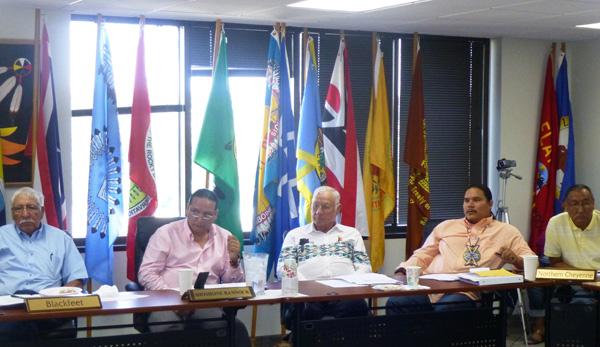
Montana-Wyoming Tribal Leaders Council representatives express grievances to Bureau of Indian Affairs and Department of Interior officials.
Adrian Jawort, Indian Country Today Media Network
The program manager for the Department Of Interior Land Buy-Back Program (LBBP) for Tribal Nations, John McClanahan, felt the heat as the frustration of Natives boiled over Friday, July 26 at the offices of the Montana-Wyoming Tribal Leaders Council offices in Billings, Montana.
Leery of a federal one-size-fits-all approach of how copy.9 billion of Cobell LBBP money allotted will be spent to purchase buy-back lands, tribal representatives from the Rocky Mountain and Great Plains areas grilled McClanahan and the BIA about the lack of transparency and cooperation between the DOI and tribal nations thus far. An estimated 70 percent of the fractional buyback acres are located in these areas.
As a result, the MT-WY TLC propose that Congressional legislation is needed to halt the DOI from holding primary purchasing control of buyback lands as well as halt bureaucratic fees that would total $285 million. It was the U.S. government that mismanaged the funds in the first place.
Frustrated with bureaucratic foot dragging, the MT-WY TLC plan to secure a meeting with President Barack Obama and Senate Committee on Indian Affairs before the November midterm elections in order to obtain Congressional support.
McClanahan tried to alleviate fears that the last year hasn’t been time wasted and they weren’t trying to push tribes aside. Bureau of Indian Affairs Director Michael Black and the BIA’s Rocky Mountain Deputy Regional Director Darrel LaCounte were also present to address grievances.
“One of the main things we’ve heard over the last couple of years of planning is tribal involvement is important,” McClanahan says. He addressed other widespread concerns he’s heard like map access of potential private land that could be bought, appraisal information, and accounts that gain interest rates for individual tribes as it waits to be spent.
“We’re trying to start out a program where everything can be balanced. We can’t work with everyone right at once, but we hope to ramp it up so we can work more tribes at once sooner,” McClanahan says.
Fort Belknap representative Donovan Archibald says he’s proposed three detailed plans to the DOI after initial implementation plan meetings were held earlier this year, but never received responses.
He told the BIA and DOI officials, “We’re the key players. You guys are working for us. If we get a contract from the government, we have to submit a proposal of what we’re going to do and that includes a plan and a budget. But you’re contracting our dollars that were awarded to us.” He notes the DOI plans to hire 100 new people to do jobs a lot of tribal members could do themselves. “We want to see a plan or budget to see how we’re going about this.”
McClanahan said many new staff members were hired to handle the mass amount of land cost appraisals. “Some tribes are interested in doing appraisals, and others aren’t,” he said. “But we just want to make sure we’re ahead of the game.”
Archibald said Fort Belknap Assiniboine-Gros Ventres Tribes have already been purchasing land for decades, and even bought 450 acres since March with the tribe’s own money. Cobell money that is supposed to be in the tribe’s possession would’ve come in handy. He also said with the salary of one DOI/BIA official with no knowledge of reservation lands, one could hire several local people on a poverty stricken reservation.
“I have 4.5 million dollars worth of sales in applications right now, and a lot of those are already appraised,” he adds. “We have our own land department and procedures and everything is legally approved by the bureau. We could be buying land right now, and so could a lot of other tribes like the Blackfeet and Northern Cheyenne. I don’t understand why we have to wait for you guys to catch up while we could be doing it.”
“We just want that reciprocal respect we’re affording the federal government,” Fort Peck Assiniboine and Sioux Tribal representative Tommy Christian says. Although Christian understands the DOI and BIA needed to protect their interests based on regulative authority, they shouldn’t patronize tribal integrity and authority while having the audacity to call them sovereign.
“That’s the part of oppression we’ve been dealing with for years, and we need to get over this. You guys got copy.9 billion dollars to help us address these problems, but you’re just giving us a little bit here and there and there to satisfy an administrative process that’s totally ineffective to us. So when I say we need to ‘come to a level playing field,’ understand where I’m coming from.”
Christian said tribes didn’t want to fight the BIA or DOI, they just wanted to make the process easier for all involved. The MT-WY TLC statement says a tribally driven process “will be a real and true step towards self-determination and a fitting legacy for Elouise Cobell.”
Perhaps venting the sentiments and concerns for all the involved tribes at the meeting, Archibald said in regards to the DOI and BIA’s perceived over involvement, “It’s the same old rhetoric: play ball with us, or you’re not going to get your money.”
Read more at https://indiancountrytodaymedianetwork.com/2013/07/29/19-billion-dispute-tribal-leaders-fuming-over-cobell-land-buy-back-program-150623
